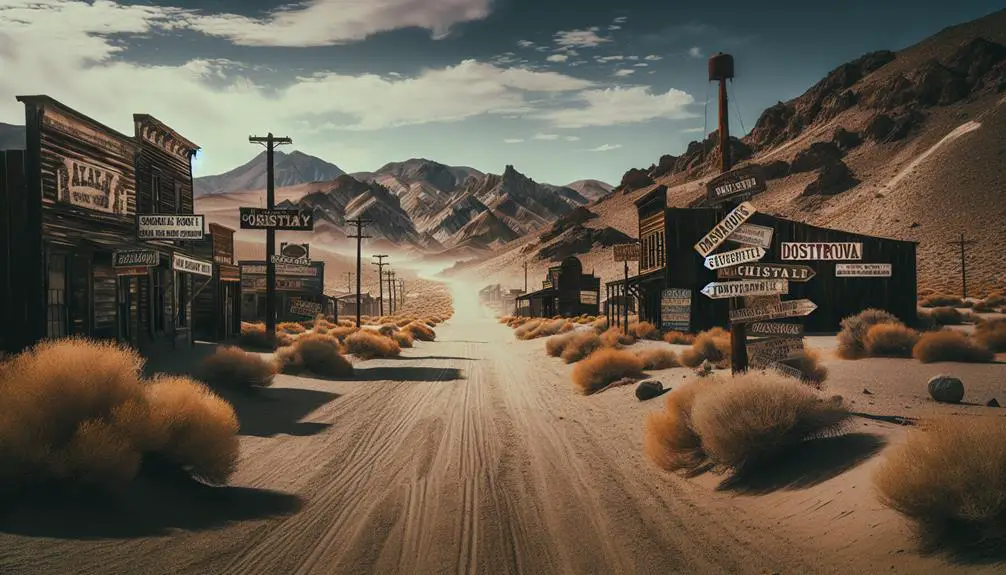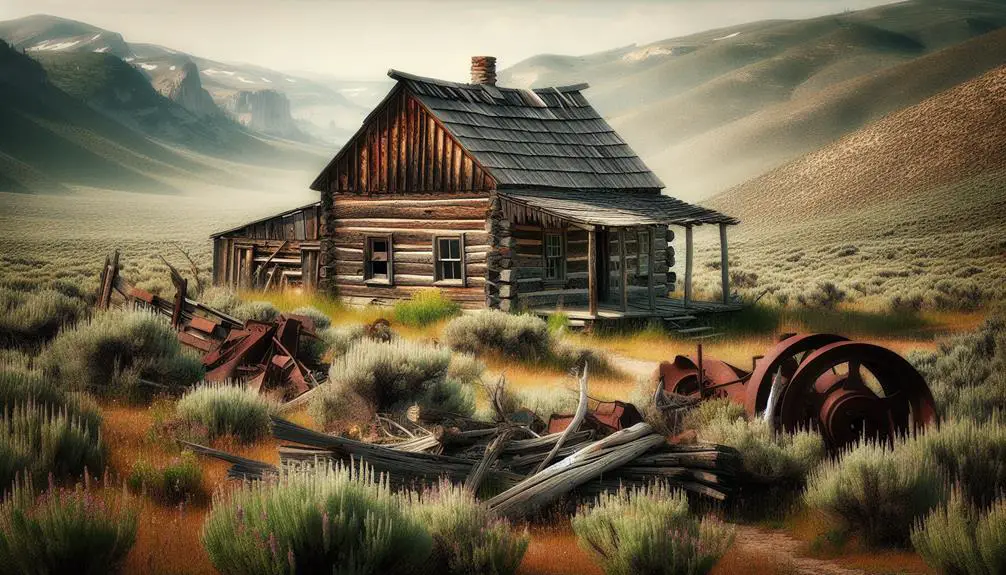Wild West ghost towns vanished due to a combination of economic shifts, environmental factors, population dynamics, technological advancements, and cultural changes. Market fluctuations and declining trade routes impacted town prosperity. Climate change and natural disasters struck vulnerable settlements. Migration patterns, social structures, and technological progress influenced their fate. Cultural shifts and urbanization drew people away from rural areas. These factors intertwined to shape the demise of these once vibrant communities.
Key Points
- Economic shifts due to declining trade routes impacted town prosperity.
- Harsh environmental conditions like droughts and wildfires led to town demise.
- Population dynamics, including rapid growth and decline, influenced settlements.
- Technological advancements, like automation and improved connectivity, affected town fate.
- Cultural changes, such as urbanization and shifting societal norms, contributed to town abandonment.
Economic Shifts Impacting Wild West Towns
Experiencing drastic economic transformations, Wild West towns faced challenges that reshaped their landscapes and communities. Market fluctuations played a pivotal role in the prosperity or downfall of these towns. When trade routes flourished, bringing in goods and people, the towns thrived, businesses boomed, and populations swelled. However, when economic decline hit and trade routes shifted, Wild West towns faced a bleak future.
The rise and fall of industries greatly influenced the economic stability of these towns. Mining towns, for instance, soared during gold rushes, attracting fortune seekers in droves. However, once the mines dried up or precious metals became scarce, these towns suffered immensely. The sudden shifts in market demands and the unpredictable nature of resource-based economies left many Wild West towns vulnerable to economic downturns.
The ability of these towns to adapt to changing economic landscapes often determined their survival. Some managed to diversify their industries, while others struggled to recover from the blows of market fluctuations. Understanding the delicate balance between trade routes and town prosperity was essential for the long-term sustainability of Wild West settlements.
Environmental Factors in Ghost Town Decline
Environmental factors played a critical role in the decline of ghost towns scattered across the Wild West. Climate change, with its unpredictable and extreme weather patterns, posed a significant threat to these frontier settlements. Droughts, floods, and wildfires, intensified by changing climatic conditions, made it challenging for residents to sustain their livelihoods. The once-thriving agricultural lands turned barren, and water sources dried up, forcing inhabitants to abandon their homes in search of more hospitable environments.
Moreover, natural disasters like earthquakes and landslides frequently struck these vulnerable towns, causing widespread destruction and loss of lives. The lack of advanced infrastructure and emergency response systems made it difficult for these communities to recover from such catastrophic events. Gradually, the combination of harsh environmental conditions and the inability to adapt to these changes led to the eventual demise of many Wild West ghost towns.
As you explore the history of these vanishing settlements, it becomes evident that environmental factors played a pivotal role in shaping their fates.
Population Dynamics of Frontier Settlements
Amidst the changing landscape of the Wild West, the intricate dynamics of population shifts within frontier settlements reveal a complex interplay of factors shaping their evolution. Migration patterns played a pivotal role in the rise and fall of these towns. Initially, settlers were drawn by the promise of new opportunities, leading to rapid population growth. However, as resources dwindled or economic activities shifted, many residents left in search of better prospects, resulting in declines that sometimes turned these settlements into ghost towns.
Social structures within these frontier settlements also influenced population dynamics. Tight-knit communities often formed, fostering a sense of belonging and cooperation among residents. However, when faced with challenges such as natural disasters or economic downturns, these social bonds were tested. Some communities banded together, while others fragmented as individuals sought solutions elsewhere.
Understanding the migration patterns and social structures of frontier settlements provides valuable insights into why some thrived while others vanished, leaving behind only echoes of the past.
Technological Advancements and Ghost Towns
The evolution of Wild West ghost towns was markedly influenced by technological advancements, shaping their fate in ways that mirrored the relentless march of progress. The advent of the Industrial Revolution played a significant role in the rise and fall of these once-thriving settlements. The introduction of automation in industries led to a decline in the need for manual labor, causing many towns to become obsolete almost overnight.
Moreover, advancements in communication and transportation further sealed the fate of these ghost towns. Improved telegraph systems and the expansion of railway networks meant that remote settlements were no longer as isolated as they once were. This increased connectivity allowed people to easily relocate to more bustling urban centers, leaving behind the quiet streets of these ghost towns.
As technology continued to advance, these once vibrant communities struggled to keep up, ultimately succumbing to the pressures of modernization. The ghost towns of the Wild West serve as a poignant reminder of the impact that technological progress can have on shaping the destiny of settlements.
Cultural Changes Leading to Town Abandonment
Changes in societal norms and values have greatly contributed to the abandonment of towns in the Wild West. Social upheaval, influenced by shifts in cultural beliefs and practices, played a significant role in the decline of these once-thriving communities. As urbanization trends began to reshape the landscape, traditional Wild West towns struggled to adapt, ultimately leading to their abandonment.
The rapid urbanization during this period drew people away from rural areas towards bustling cities, leaving many small towns deserted. The allure of city life with its promise of economic opportunities and modern amenities enticed residents to relocate, leaving behind the quiet towns of the Wild West. Additionally, social upheaval, fueled by changing attitudes towards work, family, and community, further contributed to the decline of these towns.
As societal values evolved, the once vibrant cultural fabric that held these towns together began to unravel. The sense of community that was once integral to Wild West towns eroded, leading to a lack of cohesion and ultimately contributing to their abandonment. The cultural changes that swept through the Wild West played a pivotal role in the disappearance of these ghost towns.
Frequently Asked Questions
Did Any Famous Outlaws or Lawmen Have a Significant Impact on the Decline of Wild West Ghost Towns?
Outlaw legends in the Wild West shaped the fate of ghost towns. Lawmen impact less significant. Frontier justice often prevailed over vigilante justice. Some famous outlaws like Jesse James influenced the decline through their criminal acts.
What Role Did Native American Tribes Play in the Disappearance of Frontier Settlements?
Native American relations impacted frontier settlements through complex interactions and settlement conflicts. Tribes' resistance to encroachment on their lands and clashes with settlers led to the decline and eventual abandonment of some wild west towns.
Were There Any Supernatural or Paranormal Events Reported in These Abandoned Towns?
In these deserted Wild West towns, ghostly encounters and haunted legends abound. Paranormal investigations reveal supernatural sightings that continue to intrigue visitors. The mystery of these spectral happenings adds an eerie allure to these abandoned places.
How Did the Discovery of Precious Minerals Like Gold and Silver Affect the Abandonment of These Towns?
Discovering precious minerals like gold and silver led to a mining boom in the Wild West. As resources depleted, economic shifts occurred, impacting the towns' viability. Environmental effects of mining played a role in the abandonment of these once-thriving communities.
Did Any Diseases or Epidemics Contribute to the Population Decline in Wild West Ghost Towns?
Diseases like cholera and smallpox had a significant impact on the population decline in wild west ghost towns. Outlaw influence also played a role, causing fear and chaos that contributed to the abandonment of these once-thriving communities.



